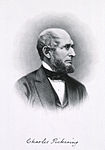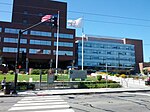Josiah Coolidge House

The Josiah Coolidge House is an historic house at 24 Coolidge Hill Road in Cambridge, Massachusetts. Located on a drumlin overlooking the Charles River, this architecturally eclectic house was built in the 1820s, and was the farmhouse of the last working farm in the city. The farmlands were developed around the turn of the 20th century, and the house underwent significant alterations around 1900. In its present configuration it is 2+1⁄2 stories in height and five bays wide, with a jerkin-headed side gable roof pierced by gable dormers, and projecting sections (left one angled, right one squared) under a flat roof.The house was listed on the National Register of Historic Places in 1983.
Excerpt from the Wikipedia article Josiah Coolidge House (License: CC BY-SA 3.0, Authors, Images).Josiah Coolidge House
Coolidge Hill Road, Cambridge
Geographical coordinates (GPS) Address Nearby Places Show on map
Geographical coordinates (GPS)
| Latitude | Longitude |
|---|---|
| N 42.374166666667 ° | E -71.138333333333 ° |
Address
Coolidge Hill Road 9
02163 Cambridge
Massachusetts, United States
Open on Google Maps










